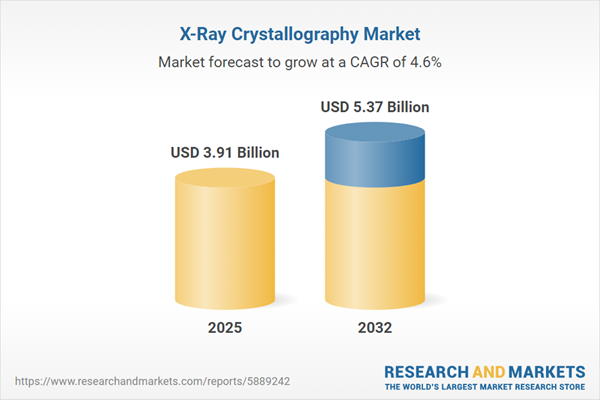Speak directly to the analyst to clarify any post sales queries you may have.
The X-ray crystallography market is a pivotal enabler for senior decision-makers seeking to advance organizational innovation, speed up research and manufacturing workflows, and maintain robust quality standards. This sector empowers enterprises to adapt proactively to evolving operational requirements and technological progress.
X-ray Crystallography Market Snapshot
Experiencing resilient expansion, the X-ray crystallography market is propelled by escalating demand for precise analytical technologies within research and manufacturing settings. Senior leaders are increasingly integrating advanced structural determination tools to streamline product development and drive productivity. As the life sciences and advanced manufacturing domains evolve, organizations are prioritizing seamless collaboration across departments to bring new solutions to market rapidly. Progress in crystallography is critical for maintaining adaptability and ensuring organizations stay ahead in a landscape defined by frequent industry shifts and a continuous emphasis on innovation.
X-ray Crystallography Market: Scope & Segmentation
This analysis addresses the needs of senior executives involved in procurement, investments, and operational oversight within the X-ray crystallography ecosystem. A clear understanding of each market segment allows for effective deployment of technology strategies and resilient market positioning.
- Instrument Type: Powder X-ray diffractometers, covering both benchtop and floor-standing models, facilitate phase analysis and dependable process quality control. Single-crystal diffractometers, equipped with microfocus sources and advanced temperature management, extend capabilities in research and development. Digital imaging equipment, such as radiography and phase-contrast systems, delivers enhanced precision for a range of material and biological assessments.
- Application: Forensic analysis supports regulatory compliance and sample accuracy. Material characterization drives new product initiatives across various industries. Pharmaceutical research uses crystallography for molecular identification and supports ongoing discovery efforts. Quality control underpins manufacturing reliability, while protein and small molecule analysis bolster advancement in scientific investigations.
- End User: Academic institutions support foundational research and technology transfer. Materials science organizations advance technical innovation. Pharmaceutical and biotechnology firms depend on crystallography to accelerate R&D. Semiconductor and electronics manufacturers leverage solutions to enhance product reliability and meet stringent standards.
- Sales Channel: Direct sales channels deliver specialized support, while distributor networks provide region-specific service and wider access to diverse markets.
- Geographic Coverage: The Americas focus on comprehensive adoption strategies. Europe leverages established collaborations and an innovation-oriented culture. Asia-Pacific, including China, India, Japan, Australia, and Southeast Asia, prioritizes facility upgrades and advanced technology uptake. The Middle East and Africa emphasize laboratory modernization and infrastructure improvements.
- Company Coverage: Prominent participants such as Bruker Corporation, Thermo Fisher Scientific Inc., Rigaku Corporation, Malvern Panalytical Limited, Agilent Technologies Inc., Shimadzu Corporation, JEOL Ltd., STOE & Cie GmbH, Anton Paar GmbH, and PerkinElmer, Inc. set trends and implement sector best practices globally.
X-ray Crystallography Market: Key Takeaways for Senior Leaders
- Advanced X-ray sources and intuitive software deliver measurable efficiency improvements and adaptable performance across laboratory and production environments.
- Integrating automation and artificial intelligence into operational workflows reduces manual error and fosters productive team collaboration in technical contexts.
- Leveraging crystallography alongside complementary methods, including cryo-electron microscopy and nuclear magnetic resonance, offers end-to-end research flexibility and comprehensive solution-building capacity.
- Flexible partnership models enable organizations to bridge existing infrastructure gaps, accelerate entry into new markets, and efficiently scale capabilities.
- Collaborative relationships with suppliers, software vendors, and research bodies equip organizations to anticipate and meet shifting market and end-user needs.
- Expanded service portfolios—including tailored training and remote support—help maintain compliance standards and operational effectiveness across distributed sites.
Tariff Impact: Navigating Supply Chain and Cost Dynamics
Recent changes in U.S. tariff policy have influenced the pricing and availability of X-ray crystallography instruments and associated components. To address these pressures, industry participants are broadening supplier bases, optimizing logistics operations, and forging regional partnerships. These responses protect research initiatives and production throughput from tariff-related disruptions and support uninterrupted innovation cycles.
Research Methodology & Data Sources
Findings in this report are developed from direct interviews with senior industry stakeholders, thorough review of technical documents, and comprehensive patent analysis. Ongoing expert consultation and examination of regulatory resources further ensure accuracy and dependability.
Why This Report Matters
- Equips decision-makers with practical benchmarks for procurement and technology strategy, supporting compliance and industry standards.
- Delivers operational and geographical guidance that supports organizational planning and effective cross-sector activities.
- Details resilient supply chain and operational approaches, supporting organizational flexibility in a rapidly changing market environment.
Conclusion
This research provides senior leaders with the context and actionable insights needed to guide informed decision-making and sustain excellence as the X-ray crystallography industry evolves.
Additional Product Information:
- Purchase of this report includes 1 year online access with quarterly updates.
- This report can be updated on request. Please contact our Customer Experience team using the Ask a Question widget on our website.
Table of Contents
3. Executive Summary
4. Market Overview
7. Cumulative Impact of Artificial Intelligence 2025
Companies Mentioned
The companies profiled in this X-Ray Crystallography market report include:- Bruker Corporation
- Thermo Fisher Scientific Inc.
- Rigaku Corporation
- Malvern Panalytical Limited
- Agilent Technologies Inc.
- Shimadzu Corporation
- JEOL Ltd.
- STOE & Cie GmbH
- Anton Paar GmbH
- PerkinElmer, Inc.
Table Information
| Report Attribute | Details |
|---|---|
| No. of Pages | 190 |
| Published | November 2025 |
| Forecast Period | 2025 - 2032 |
| Estimated Market Value ( USD | $ 3.91 Billion |
| Forecasted Market Value ( USD | $ 5.37 Billion |
| Compound Annual Growth Rate | 4.6% |
| Regions Covered | Global |
| No. of Companies Mentioned | 11 |









